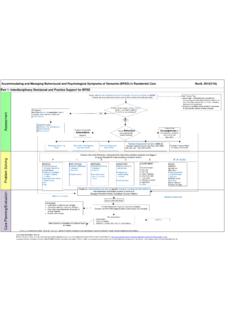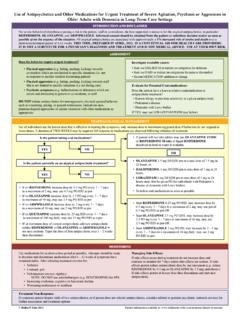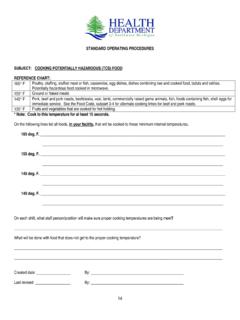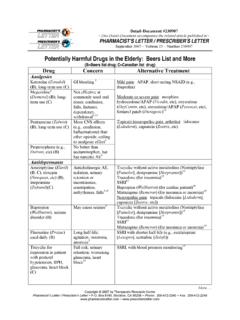Transcription of AGS BEERS CRITERIA TABLE 1: FOR POTENTIALLY …
1 TABLE 1 (continued from page 1). AGS BEERS CRITERIA TABLE 1: 2012 AGS BEERS CRITERIA for POTENTIALLY inappropriate medication Use in Older Adults Organ System/ Recommendation, Rationale, FOR POTENTIALLY inappropriate Therapeutic Category/Drug(s) Quality of Evidence (QE) & Strength of Recommendation (SR). Antispasmodics Avoid except in short-term palliative care to decrease medication USE IN OLDER ADULTS n Belladonna alkaloids oral secretions. n Clidinium-chlordiazepoxide FROM THE AMERICAN GERIATRICS SOCIETY n Dicyclomine Highly anticholinergic, uncertain effectiveness. n Hyoscyamine This clinical tool, based on The AGS 2012 Updated BEERS CRITERIA for POTENTIALLY inappropriate medication Use in Older n Propantheline QE = Moderate; SR = Strong Adults (AGS 2012 BEERS CRITERIA ), has been developed to assist healthcare providers in improving medication safety in n Scopolamine older adults.
2 Our purpose is to inform clinical decision-making concerning the prescribing of medications for older adults in order to improve safety and quality of care. Antithrombotics Dipyridamole, oral short-acting* (does not Avoid. Originally conceived of in 1991 by the late Mark BEERS , MD, a geriatrician, the BEERS CRITERIA catalogues medications apply to the extended-release combination with May cause orthostatic hypotension; more effective alternatives that cause adverse drug events in older adults due to their pharmacologic properties and the physiologic changes of aspirin) available; IV form acceptable for use in cardiac stress testing. aging. In 2011, the AGS undertook an update of the CRITERIA , assembling a team of experts and funding the develop- QE = Moderate; SR = Strong ment of the AGS 2012 BEERS CRITERIA using an enhanced, evidence-based methodology. Each criterion is rated (qual- Ticlopidine* Avoid.)
3 Ity of evidence and strength of evidence) using the American College of Physicians' Guideline Grading System, which Safer, effective alternatives available. is based on the GRADE scheme developed by Guyatt et al. QE = Moderate; SR = Strong The full document together with accompanying resources can be viewed online at Anti-infective Nitrofurantoin Avoid for long-term suppression; avoid in patients with INTENDED USE CrCl <60 mL/min. The goal of this clinical tool is to improve care of older adults by reducing their exposure to POTENTIALLY Inappropri- Potential for pulmonary toxicity; safer alternatives available; lack of ate Medications (PIMs). efficacy in patients with CrCl <60 mL/min due to inadequate drug n This should be viewed as a guide for identifying medications for which the risks of use in older adults outweigh concentration in the urine. the benefits. QE = Moderate; SR = Strong n These CRITERIA are not meant to be applied in a punitive manner.
4 N This list is not meant to supersede clinical judgment or an individual patient's values and needs. Prescribing and Cardiovascular managing disease conditions should be individualized and involve shared decision-making. Alpha1 blockers Avoid use as an antihypertensive. n These CRITERIA also underscore the importance of using a team approach to prescribing and the use of non- n Doxazosin High risk of orthostatic hypotension; not recommended as routine n Prazosin treatment for hypertension; alternative agents have superior risk/. pharmacological approaches and of having economic and organizational incentives for this type of model. n Implicit CRITERIA such as the STOPP/START CRITERIA and medication Appropriateness Index should be used in n Terazosin benefit profile. a complementary manner with the 2012 AGS BEERS CRITERIA to guide clinicians in making decisions about safe QE = Moderate; SR = Strong medication use in older adults.
5 Alpha agonists Avoid clonidine as a first-line antihypertensive. Avoid oth- n Clonidine ers as listed. The CRITERIA are not applicable in all circumstances (eg, patient's receiving palliative and hospice care). If a clinician is n Guanabenz* High risk of adverse CNS effects; may cause bradycardia and not able to find an alternative and chooses to continue to use a drug on this list in an individual patient, designation n Guanfacine* orthostatic hypotension; not recommended as routine treatment of the medication as POTENTIALLY inappropriate can serve as a reminder for close monitoring so that the potential for n Methyldopa* for hypertension. an adverse drug effect can be incorporated into the medical record and prevented or detected early. n Reserpine (> mg/day)* QE = Low; SR = Strong Antiarrhythmic drugs (Class Ia, Ic, III) Avoid antiarrhythmic drugs as first-line treatment of atrial n Amiodarone fibrillation.
6 TABLE 1: 2012 AGS BEERS CRITERIA for POTENTIALLY inappropriate medication Use in Older Adults n Dofetilide n Dronedarone Data suggest that rate control yields better balance of benefits and Organ System/ Recommendation, Rationale, n Flecainide harms than rhythm control for most older adults. Therapeutic Category/Drug(s) Quality of Evidence (QE) & Strength of Recommendation (SR). n Ibutilide Anticholinergics (excludes TCAs) n Procainamide Amiodarone is associated with multiple toxicities, including thyroid First-generation antihistamines (as single Avoid. n Propafenone disease, pulmonary disorders, and QT interval prolongation. agent or as part of combination products) n Quinidine QE = High; SR = Strong n Brompheniramine Highly anticholinergic; clearance reduced with advanced age, and n Sotalol n Carbinoxamine tolerance develops when used as hypnotic; increased risk of confu- Disopyramide* Avoid.
7 N Chlorpheniramine sion, dry mouth, constipation, and other anticholinergic effects/ Disopyramide is a potent negative inotrope and therefore may n Clemastine toxicity. induce heart failure in older adults; strongly anticholinergic; other n Cyproheptadine antiarrhythmic drugs preferred. n Dexbrompheniramine Use of diphenhydramine in special situations such as acute treat- QE = Low; SR = Strong n Dexchlorpheniramine ment of severe allergic reaction may be appropriate. n Diphenhydramine (oral). Dronedarone Avoid in patients with permanent atrial fibrillation or heart failure. n Doxylamine QE = High (Hydroxyzine and Promethazine), Moderate (All others); SR. n Hydroxyzine = Strong Worse outcomes have been reported in patients taking drone- n Promethazine n Triprolidine darone who have permanent atrial fibrillation or heart failure. In general, rate control is preferred over rhythm control for atrial Antiparkinson agents Avoid.
8 Fibrillation. n Benztropine (oral) QE = Moderate; SR = Strong n Trihexyphenidyl Not recommended for prevention of extrapyramidal symptoms Digoxin > mg/day Avoid. with antipsychotics; more effective agents available for treatment of In heart failure, higher dosages associated with no additional Parkinson disease. benefit and may increase risk of toxicity; decreased renal clearance may increase risk of toxicity. QE = Moderate; SR = Strong QE = Moderate; SR = Strong PAGE 1 TABLE 1 (continued on page 2) PAGE 2 TABLE 1 (continued on page 3). TABLE 1 (continued from page 2) TABLE 1 (continued from page 3). TABLE 1: 2012 AGS BEERS CRITERIA for POTENTIALLY inappropriate medication Use in Older Adults TABLE 1: 2012 AGS BEERS CRITERIA for POTENTIALLY inappropriate medication Use in Older Adults Organ System/ Recommendation, Rationale, Organ System/ Recommendation, Rationale, Therapeutic Category/Drug(s) Quality of Evidence (QE) & Strength of Recommendation (SR) Therapeutic Category/Drug(s) Quality of Evidence (QE) & Strength of Recommendation (SR).
9 Nifedipine, immediate release* Avoid. Nonbenzodiazepine Avoid chronic use (>90 days). hypnotics Benzodiazepine-receptor agonists that have adverse events similar Potential for hypotension; risk of precipitating myocardial ischemia. n Eszopiclone to those of benzodiazepines in older adults ( , delirium, falls, QE = High; SR = Strong n Zolpidem fractures); minimal improvement in sleep latency and duration. Spironolactone >25 mg/day Avoid in patients with heart failure or with a CrCl <30. n Zaleplon QE = Moderate; SR = Strong mL/min. Ergot mesylates* Avoid. Isoxsuprine* Lack of efficacy. In heart failure, the risk of hyperkalemia is higher in older adults if QE = High; SR = Strong taking >25 mg/day. Endocrine QE = Moderate; SR = Strong Androgens Avoid unless indicated for moderate to severe Central Nervous System n Methyltestosterone* hypogonadism. Tertiary TCAs, alone or in combination: Avoid.
10 N Testosterone Potential for cardiac problems and contraindicated in men with n Amitriptyline prostate cancer. n Chlordiazepoxide- Highly anticholinergic, sedating, and cause orthostatic hypotension; QE = Moderate; SR = Weak amitriptyline the safety profile of low-dose doxepin ( 6 mg/day) is comparable Desiccated thyroid Avoid. n Clomipramine to that of placebo. Concerns about cardiac effects; safer alternatives available. n Doxepin >6 mg/day QE = Low; SR = Strong n Imipramine QE = High; SR = Strong n Perphenazine-amitriptyline Estrogens with or without progestins Avoid oral and topical vaginal cream: Ac- n Trimipramine ceptable to use low-dose intravaginal estrogen for the management of dyspareunia, lower urinary tract infec- Antipsychotics, first- (conventional) and sec- Avoid use for behavioral problems of dementia unless tions, and other vaginal symptoms. ond- (atypical) generation (see online for full list) non-pharmacologic options have failed and patient is Evidence of carcinogenic potential (breast and endometrium); lack threat to self or others.







